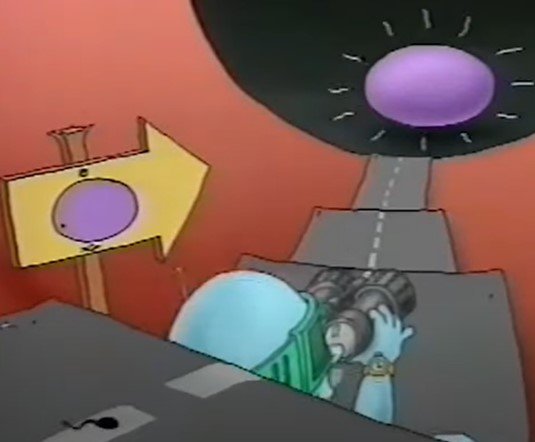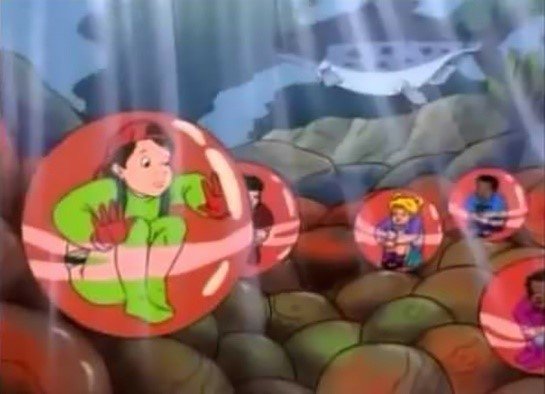Come, Again: Exploring the Sticky Business of Animated Sperm
As someone who was schooled in the UK between the mid-1990s and mid-2000s, I don’t have extensive memories of the formal teaching of sex education, for such classes were embarrassingly few. Despite the lack of constructive lessons offered then by the UK school system, I nevertheless retain a strong conviction that sperm is, in essence, a highly animated substance. Long before it existed in any other capacity to me, sperms had the look and personality of an animated character. Indeed, even in the two-dimensional, static forms that populated middle school biology textbooks, illustrations of sperm were typified by qualities that are commonplace in animation, conceptualised zoomorphically as tadpoles with rippling tails that conveyed movement in their curvature.
Given that animation has historically been linked to young audiences by virtue of Disney’s prominence, it is the medium’s capacity to process the world into comprehensible shapes that it has made it popular as a pedagogical tool. It is arguably via sex education films that sperm’s animated form was compounded in the popular imagination. Often conservatively geared toward heterocentric coupling and, therefore, reproduction, such films frequently employed animation to cater those young viewers believed to be unready for the abject “horror” of live action imagery detailing changes in the body and sexuality – see, for instance, Disney’s 1946 animated short The Story of Menstruation.[1] As Nea Ehrlich writes, “[u]sing animation to portray ‘the real’ reflects a cultural shift whereby animation departs from childhood- or fantasy-oriented imagery, to engage increasingly with factual content”, to the extent that it came to “straddle an interesting line between fiction and non-fiction” (2021: 3). Indeed, as early as the 1940s animation was being redeployed to do representational heavy lifting in reference to the body and its processes, an approach that seemingly sought to reframe abstract biological diagrams into more palatable designs while sidestepping mid-century censorial measures regarding explicit imagery.[2] In this blog, I will survey the ways animators achieved this while projecting a series of specific historical ideas regarding the body; following that I will map out more recent representations of sperm as it became a mainstay of adult animation both humorous and not.
Sex education films historically reflect a cultural battleground concerning the most effective and responsible way to generate discourse on sexuality and the changing body. As Hera Cook notes, “by the late 1960s, the sexual culture was derided as Victorian and irrational, the product of a neurotic, subconscious resistance to sex” (2009: 7). Animation’s answer to this crisis is clearly abstraction. For Paul Wells, animation’s abstract or metamorphic capacity is rooted in “the ability for an image to literally change into another completely different image” (1998: 69). Figures 1 and 2, taken from Health E: Sex Education (1995), explicate the type of abstract animated imagery that found its way into mid-1990s sex education films. According to this film, typical of its era, “cool” sperms equipped with shades and a Walkman set out in search of the egg, which passively looms over the proceedings like the mysterious monolith of 2001: A Space Odyssey (Stanley Kubrick, 1968). Such films created fantasias of uncanny representation that I argue are androcentric in terms of biological symbolism and toxically masculine in terms of characterisation.
Sperm-bro not only implies (by his overt anthropomorphism) that the child originates in the ejaculate, but that the egg functions solely as an incubator rather than the site and supplier of vital genetic materials. Furthermore, this sperm is a confident extrovert that contributes to a vocabulary concerning conception that is semantically redolent of victories in athletic trials and/or battles – consider the common parlance regarding the sperm that “won the race” and so forth – when in fact science reflects a far less individualistic and more communal effort toward insemination. One might wonder if much animation is, to borrow Sergei Eisenstein’s term, formally “plasmatic” (2017) and understood to be so then why does sperm-bro’s depiction matter in the grand scheme of things? There is, however, an ideological underpinning that is not only problematic, but preponderant in the popular representation of animated sperm. Wells makes the significant point in his book Understanding Animation that “the idea that animation is an innocent medium, ostensibly for children … has done much to inhibit the proper discussion of issues concerning representation” (1998: 187). Echoing Wells’ proclamation that representation in animation matters, sperm-bro demonstrates how imagining sperms (and, therefore, children) as champions and warriors might trickle down into a discourse of exceptionalism that, especially in boys, is the very substance of toxic masculinity. Sperm-bro’s not looking so chill now, is he?
The mainstreaming of educational animation simultaneously procures child consumers while naturalising systems of representation. Amy Ratelle is particularly critical of the corrupt ramifications of educational animation, noting that pedagogical aspirations do not undo the capitalist prerogatives explicated by US educational children’s shows such as Sesame Street (PBS, 1969–). She argues that “shifts in thinking about children’s animation reflect larger cultural tensions around children in terms of pedagogical value, emotional development and entertainment, as situated in capitalist culture” (2019: 199). Reflective of both this contentious mode, and of animated sperm’s adoption in the wider culture of animations aimed at young viewers, is an infamous episode of The Magic School Bus (PBS, 1994-7), where a group of school children get transformed into fish eggs before being ejaculated on by a large fish (“TMSB goes upstream”, season 3, episode 8), which demonstrates once again the frequency with which animation is employed to explain bodily processes (Figs. 3 and 4).
Tonally indeterminate as it is, which may or may not explain its commercial failure, Osmosis Jones (Bobby and Peter Farrelly, 2001) is the feature film that most capitalised on the interplay between animation’s educational-entertainment aspect and its tenacity to depict various types of bodily viscera. The film is an interesting steppingstone for observing how animation has been employed to represent bodily processes in children’s and adult media. While animation as a territory for adult media pre-dates the modern era – see, for example, the works of Ralph Bakshi[3] – there is nevertheless an aesthetic slipperiness to contemporary examples of the form that conveys a reflexive engagement with the child/adult dichotomy that defines the primary discourse on animation and its intended audience. Indeed, from turn-of-the-century examples post-The Simpsons (Fox, 1989–) such as South Park (Comedy Central, 1997–) and Family Guy (Fox, 1999–) to more recent works including Big Mouth (Netflix, 2017–), contemporary adult animation demonstrates, and plays with, a near constant awareness of the medium’s preponderance among young audiences. This is precisely the basis of an episode-long joke in one episode of South Park (“The Simpsons Already Did It”, season 6, episode 7), which plays on a childlike inability to differentiate between the sea-people they are farming in Cartman’s bedroom and the semen that has supposedly been found in their deceased teacher’s stomach, for which they believe they are responsible.[4] As he spoons semen from a mixing bowl into a re-purposed fish tank (Fig. 5), Cartman reveals it was acquired from “Ralph in an alley … who made him close [his] eyes and suck it out of a hose”, demonstrating in extremis perhaps their willingness to exceed The Simpsons’ transgressive limits.
Also operating in this parodic realm is an episode of Family Guy that sees a microscopic Stewie doing battle with his would-be siblings in a Star Wars-styled (George Lucas, 1977) battle between sperm spaceships inhabited by fully formed children serving testicular Death Stars (“Emission Impossible”, season 3, episode 11) (Fig.6 ). It must be more than coincidence that this sequence resembles the sex education film mentioned above – by way of a Star Wars reference that is commonplace in Family Guy – by transforming fertilisation into a heroic quest narrative that propagates the androcentric notion that the baby (in this case Stewie) originates wholly in the man. There is an ideological basis of concern about this. As Samantha Langsdale and Sarah Myers note in their analysis of Tangled’s (Nathan Greno and Byron Howard, 2010) revisionist approach to gender, a historical survey of fairy tales – a mode on which much popular animation depends – reveals a tendency to propel myths that are bound “within a specifically patriarchal framework” of representation (2018: 245) that is reflected in sperm-bro and more recently Family Guy.
Big Mouth, meanwhile, a more recent adult animated series that sheds grotesque light on the trials of coming-of-age, diverges slightly from Family Guy’s precedent to depict sperms as fully fledged children. In keeping with its intentionally ugly style, the sperms that feature in the opening episode (“Ejaculation”) are more alien, and what might be described as inter-anthropomorphic in appearance (Fig. 7). They have human-like faces but are evidently less humanoid than other examples. Andrew, having ejaculated during his first slow dance, flushes his sperm down a school toilet before dropping his phone into the bowl and climbing in after it Trainspotting-style (Danny Boyle, 1996). There, in the toilet bowl, he is chastised by his sperm for not releasing them into a vagina. As I have written elsewhere, “by offering a nuanced, sensitive and metatextual examination of teen representation, Big Mouth makes a clear argument for the need to create a transparent discourse on sex education for the benefit of young people” (2020: 124). Yet, despite its honourable intentions, the show nevertheless fails to advocate for Andrew’s right to choose where to put his sperm and, in doing so, reinforces conservative notions that reproductive sex is biologically determined to be the best kind. Arguably outdoing Big Mouth’s lack of subtlety and proving once and for all that, hard as it may be to swallow, perhaps animated sperm is just funny, another Netflix series Paradise PD (2018–) displays an almost pornographic level of abundance as geriatric police officer Stanley Hobson, a.k.a. Splooge McDuck, swan dives into a swimming pool of semen.
It would be oversighted to not at least mention those extremely graphic animated texts that enter into a pornographic realm of representation. Examples include extremely violent (and sexually violent) animated films such as Urotsukidōji: Legend of the Overfiend (Hideki Takayama, 1989) to OVA hentai works such as Bible Black: New Testament (Kitty Media, 2004-9).[5] The latter finds a group of teens doing battle with supernatural forces and their own sexual desires in a series that features not only every sex act imaginable (and unimaginable), but enough semen to drown the average, unassuming censor. Popular as they are for their erotic and cult dimensions, such titles are unsurprisingly controversial in many circles for a tendency to feature wanton scenes of sexual violence and “children [that] are presented as sexually active” (BBFC 2006). Moreover, there exists a whole portion of the internet dedicated to unofficial fan interactions with various media franchises, including some who express interests in making adult – or pornifying – non-adult source materials from Disney features to various other works.[6] All in all, animation’s capacity to stretch sex in all its dimensions and be aesthetically transgressive for its conflation of children’s and adult media has not been lost on independent and underground creators.
Thus far, much has been made of the stretch and squash that define the physical laws relating to animated bodies, but what I ask has been made of animation that squirts? Preliminary as this survey is, it indicates a sticky overlap of animated forms that feed in and out of one another; indeed, the cultural life cycles of animated sperm bridge a variety of different contexts from educationally focused films to a source of lewd humour to a substance with naturally erotic potential. Coinciding with a broad spectrum of discursive utilities in which sperm features as a biological fact, a source of humour, and an arousing substance, sperm and animation clearly share formal characteristics that are located in their cultural and physical viscosity.
**Article published: May 20, 2022**
Notes
[1] For British examples, see the BFI’s 2009 collection of historical sex education films released as The Joy of Sex Education on DVD.
[2] See, for an example of this form, Six Little Jungle Boys (John Halas and Joy Batchelor, 1945) an educational animated film aimed at hygiene that was produced by the British War Office.
[3] Alexander Sergeant observes Ralph Bakshi as a counter-cultural iconoclast (2018: 141-57), a status that positions him within differently oriented cultures of production and reception than the mainstream adult animation I will consider here.
[4] For Jeffrey Andrew Weinstock, South Park’s willingness to do what a less adult show like The Simpsons will not characterises the strategic value of “differential signifi[cation] … whose meaning is precisely dependent on the fact that it is both similar to and different from other animated programs” (2008: 79).
[5] An anime adaptation of cult eroge video game Bible Black (ActiveSoft, 2000).
[6] See, for a popular example, explicit fan fiction/art relating to the My Little Pony (Hasbro et al., 1981–) media franchise.
References
BBFC (2006). “Drawing Comparisons: the history of Manga and Classification”. Available at <http://www.bbfc.co.uk/education-resources/education-news/drawing-comparisons-history-manga-and-classification>.
Hera Cook (2009). “ ‘They shan’t suffer the agony of mind we suffered’: Self-Control and Sex Education”, DVD booklet, The Joy of Sex Education, BFI, pp. 5-8.
Nea Ehrlich (2021). “Viral Imagery: The Animated Face of Covid-19”, Visual Resources, DOI: 10.1080/01973762.2021.1960777.
Sergei Eisenstein (2017) in Jay Leyda, ed., Sergei Eisenstein on Disney. London: Seagull Books.
Eddie Falvey (2020). “Situating Netflix’s Original Adult Animation: Observing Taste Cultures and the Legacies of ‘Quality’ Television through BoJack Horseman and Big Mouth”, Animation: An Interdisciplinary Journal, vol 15(2), pp. 116-29.
Samantha Langsdale and Sarah Myers (2018). “The Evolution of Reproductive Fantasies: An Interdisciplinary Feminist Analysis of Tangled” in C. Holliday and A. Sergeant, eds, Fantasy/Animation: Connections Between Media, Mediums and Genres. New York and London: Routledge, pp. 243-60.
Amy Ratelle (2019). “Animation and/as Children’s Entertainment” in N. Dobson, A. Honess Roe, A. Ratelle and C. Ruddell, eds, The Animation Studies Reader. New York and London: Bloomsbury, pp. 191-202.
Alex Sergeant (2018). “The Iconoclast of Animation: Counter-culturalism in Ralph Bakshi’s Animated Films” in C. Holliday and A. Sergeant, eds, Fantasy/Animation: Connections Between Media, Mediums and Genres. New York and London: Routledge, pp. 141-57.
Jeffrey Andrew Weinstock (2008). “ ‘Simpsons Did It’: South Park as Differential Signifier” in J. A. Weinstock, ed., Taking South Park Seriously. New York: State University of New York Press, pp. 79-96.
Paul Wells (1998). Understanding Animation. London: Routledge.
Biography
Dr Eddie Falvey is an early career researcher and currently lectures in the School of Arts and Media Studies at Plymouth College of Art, UK. Eddie completed his AHRC funded PhD at the University of Exeter in 2018, work that forms the basis of his forthcoming monograph New York in Early Films: The Archive and the City (University of Amsterdam Press, forthcoming). He is author of the Devil’s Advocates volume Re-Animator (Liverpool University Press, 2021), editor of The Cinema of Yorgos Lanthimos: Films, Form, Philosophy (Bloomsbury, 2022) and co-editor of New Blood: Critical Approaches to Contemporary Horror (with Joe Hickinbottom and Jonathan Wroot, University of Wales Press, 2020). Elsewhere, he has had work published in a number of journals and edited collections.











Animation is inherently queer. The very process of destabilising the rigid boundaries of the human body and abstracting it into shapes and colours that we can project ourselves onto is essentially a process of queering. In their article “Why Are Cartoons So Queer?” for Sunstroke Magazine, Kellie Toyama remarks that “the flexible nature of animation gives stories the added potential to introduce fluid concepts of gender and sexuality with ease,” making animation the perfect medium to visualise the queer experience. As Paul Wells states, “the animated film has the capacity to redefine orthodoxies of live-action narrative and images,” an analysis that Kodi Maier elaborates on by linking his discussion directly to queer theory: “animation’s elasticity opens a realm where ideas of normalcy are disrupted and hidden potentials are revealed much in the same way that queer theory disrupts common understandings of gender and sexuality to explore other options in regards to embodiment and expression.” Why is it, then, that mainstream animation has for so long been afraid of queerness?